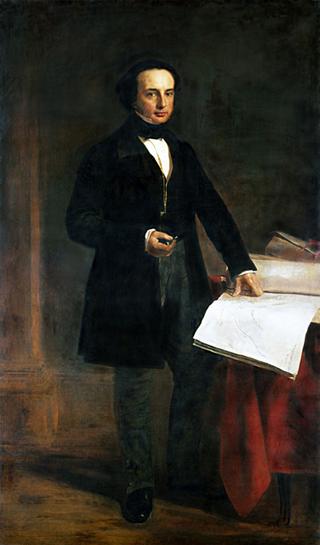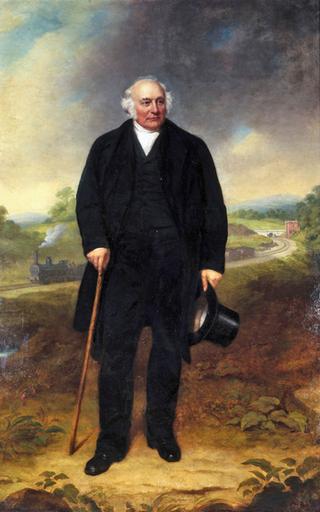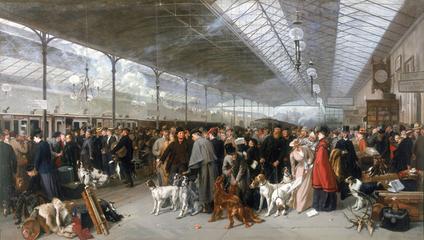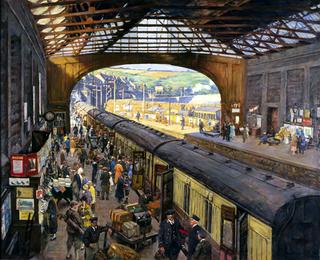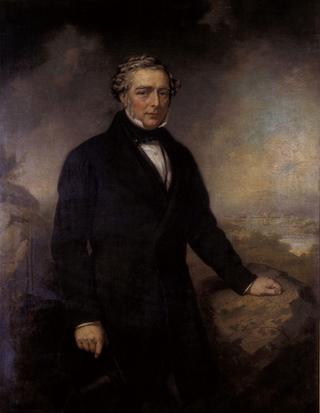
Two watercolours, Coolies and bullock hackeries collecting materials, and Bengalee brickmaking
- maker:
- G W Archer




Paintings, two watercolours on paper showing brickmaking for the East Indian Railway, by G W Archer, 1852. On the obverse is the painting, East Indian Railway, Coolies and bullock hackeries collecting materials / a peepul tree on the right. It depicts three Bihari labourers with two bullock carts at the edge of a wood. One has a pile of bricks balanced on his head, another sits on a cart, and a third appears to be wrapping something in a cloth. The painting is signed at bottom left "GWA". Title in ink in manuscript text below with the additional words "G.T. 3rd Nov. 1852". The painting is 241 x 203mm. It has at one time been folded laterally into three. On the reverse is another watercolour, Bengalee brickmaking drawn by Mr Archer. It depicts six Bihari labourers digging clay and shaping rows of bricks, with large stacks of bricks drying in the background. It is signed at bottom left "G W Archer". The title is inscribed in ink, in manuscript, below. This painting is 106 x 198mm. It has a fold running laterally about a third from the top. Both watercolours have been pasted onto a sheet of paper, 296 x 233mm. From the collection of George Turnbull, Chief Engineer of the East Indian Railway.
The first of these two watercolours depicts Bihari labourers collecting construction materials. In India, the term coolie usually refers to a porter, a person who carries cargo for others. In some other areas of the world, the term refers generally to a low-wage labourer and can be now considered offensive. However, in modern Indian popular culture, coolies have been portrayed as working-class heroes, such as in the film Coolie No. 1 (1991) and in its many subsequent remakes.
A bullock hackery is a two-wheeled coach pulled by a cow that was a popular method of transporting goods and people in nineteenth century India and continues to be used today. The peepul tree or bodhi tree (ficus religiosa) holds religious significance in three religions. Hindus and Jains consider it a sacred tree and meditate beneath it, and it was under a bodhi tree that Buddha attained enlightenment.
The second of the watercolours depicts the process of handmaking bricks. The Bihari labourers mould the clay into a brick shape using their hands and then line them up in rows. Rather than firing the bricks, as we might be used to nowadays in the UK, the Bihari labourers simply waited. Sooner or later the sun does its job, and the clay dries. This process of air-drying bricks has a long history, dating back perhaps as far as 9,000 BCE.
Scottish engineer George Turnbull (1809-1889) oversaw the creation of one of the first railways in India, the East Indian Railway (EIR). The EIR ran from near Calcutta (now Kolkata), an East India Company trading post in the north-east that the Company established as the capital from 1773. The terminus was originally Benares (now Varanasi), but the line quickly extended to New Delhi in the north, which became the capital of India in 1911. Calcutta and New Delhi are over 1,300km miles from each other – further than the distance between Paris, France and Budapest, Hungary.
Turnbull collected artworks during his time in India, many of which were produced by EIR engineers. These watercolours and drawings provide a rare view of nineteenth-century India from the perspective of the British engineers designing and building the country’s first railways. The collection includes landscape scenes and portraits. While many of the landscapes show the construction of the railway, others focus entirely on India’s local architecture or its rural spaces. The portraits are of people Turnbull encountered while in India. While the portraits of British people are inscribed with their names, most of the Indian people depicted remain anonymous or identified only by their job.
The British introduced railways in India to satisfy the mounting economic and military needs of their colonial administration. They hoped that the new technology would foster an increased sense of collective identity by making it easier to travel quickly between distant regions. They also hoped the railways would socially ‘improve India’ by instilling a sense of punctuality among Indians, a quality British colonialists believed Indians lacked. The racist stereotypes underpinning these intentions, and the interconnected idea that technology could trigger social change, were common beliefs in nineteenth-century British society.
Details
- Category:
- Pictorial Collection (Railway)
- Object Number:
- 2017-7089
- Materials:
- ink, paper (fibre product) and watercolour (paint)
